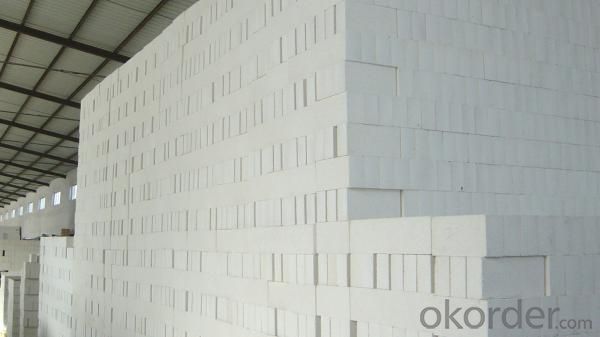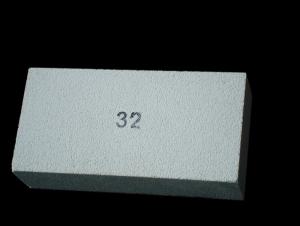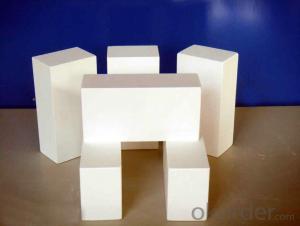Insulating Fire Brick - MS26
- Loading Port:
- China Main Port
- Payment Terms:
- TT or L/C
- Min Order Qty:
- 1000 pcs pc
- Supply Capability:
- 1000 Tons Per Month pc/month
OKorder Service Pledge
OKorder Financial Service
You Might Also Like
General Information of Insulating Fire Brick MS26
Our insulating fire bricks GJM23 temperature is 1430℃(2600℉). We could supply a wide range of shapes.
Feature of Insulating Fire Brick MS26
Light weight and low thermal conductivity
Low heat storage
High thermal shock resistance
Application of Insulating Fire Brick MS26
Our insulating firebricks can be used as a hot face lining directly exposed to the heat or as a backup insulation layer in iron and steel mills, non-ferrous foundries, petrochemical, ceramic, glass.
Technical Data of Insulating Fire Brick MS26
|
| MS26 |
Physical Properties: |
|
|
Classifiction Temperature | ℃ | 1430.0 |
Density | Kg/m3 | 850.0 |
Cold Crushing Strength | Mpa | 2.0 |
Reheating Linear Change(24hrs) |
|
|
1400℃ | % | 0.5 |
Hot Load Strength Deform(90 minutes) |
|
|
1260℃ at 0.069 Mpa(10psi) | % | 0.2 |
Thermal Conductivity |
|
|
400℃ | W/m.k | 0.3 |
600℃ | W/m.k | 0.3 |
800℃ | W/m.k | 0.3 |
1000℃ | W/m.k | 0.3 |
1200℃ | W/m.k | 0.4 |
Specific Heat | KJ/Kg.K | 1.1 |
Chemical Analysis: |
|
|
Al2O3 | % | 50.0 |
SiO2 | % | 47.1 |
Fe2O3 | % | 0.7 |
TiO2 | % | 0.1 |
CaO | % | 0.1 |
MgO | % | 0.2 |
Na2O+K2O | % | 1.7 |
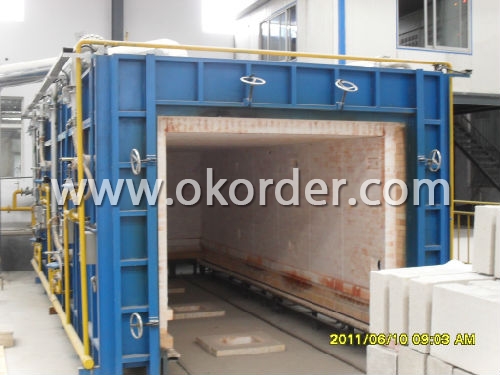
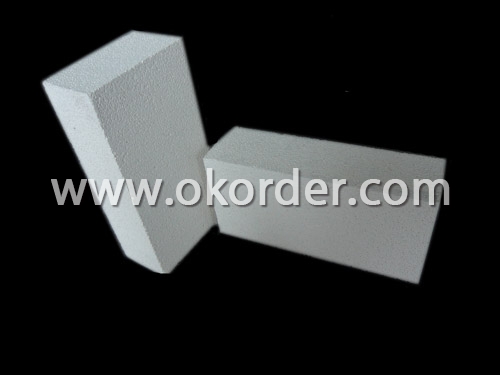
- Q: Can insulating fire bricks be used in the construction of brick ovens?
- Brick ovens can indeed utilize insulating fire bricks. These specialized bricks possess exceptional thermal insulation characteristics, which make them highly suitable for applications that require efficient heat retention, such as brick ovens. Crafted from lightweight refractory materials, these bricks exhibit a lower density compared to standard clay bricks, thereby minimizing heat loss and enhancing energy efficiency. When constructing a brick oven, it is crucial to contemplate the insulation layer responsible for preserving and evenly disseminating heat throughout the oven. Insulating fire bricks can be employed to create this insulation layer, typically positioned between the inner cooking chamber and the outer oven layer. By utilizing these bricks, heat transfer to the outer layer is minimized, preventing excessive heat dissipation and ensuring the oven attains and maintains the desired high temperatures essential for baking or cooking. Apart from their impressive thermal insulation properties, insulating fire bricks also exhibit remarkable resistance to thermal shock. This signifies their ability to endure abrupt temperature changes without cracking or fracturing. This quality is particularly valuable in brick ovens, as they frequently encounter significant temperature fluctuations during the baking process. To sum up, insulating fire bricks are a fitting and highly recommended choice for constructing brick ovens due to their thermal insulation properties, lightweight composition, and resilience to thermal shock. By utilizing these bricks, a well-insulated and efficient oven can be created, capable of achieving and sustaining high temperatures for optimal baking or cooking outcomes.
- Q: Are insulating fire bricks resistant to thermal shock cracking?
- Yes, insulating fire bricks are resistant to thermal shock cracking. These bricks are specifically designed to withstand high temperatures and rapid changes in temperature without cracking. They have a low thermal conductivity, which means they can effectively trap and retain heat without being damaged by thermal shock. Insulating fire bricks are often used in applications where thermal shock is a concern, such as in furnaces, kilns, and other high-temperature environments. Their resistance to thermal shock cracking makes them a reliable choice for these types of applications.
- Q: Can insulating fire bricks be used for fireplace construction?
- Indeed, insulating fire bricks are suitable for constructing fireplaces. These bricks are specifically engineered to endure extreme temperatures while offering superb insulation, rendering them perfect for lining fireplaces. They aid in retaining heat, improving fireplace efficiency, and preventing heat dissipation. Furthermore, insulating fire bricks possess a lightweight quality, facilitating easier handling and installation. Ultimately, opting for insulating fire bricks in fireplace construction is a pragmatic decision that can enhance fireplace performance and energy efficiency.
- Q: What is the recommended curing time for insulating fire bricks?
- The recommended curing time for insulating fire bricks can vary depending on several factors such as the type of brick, the specific application, and the manufacturer's instructions. However, in general, it is advisable to allow a curing time of at least 24 to 48 hours for insulating fire bricks. This allows the bricks to dry and harden properly, ensuring their stability and performance in high-temperature environments. It is important to follow the manufacturer's guidelines and recommendations for curing time to achieve the best results. Additionally, factors such as humidity, temperature, and ventilation can also influence the curing process, so it is important to consider these factors when determining the appropriate curing time for insulating fire bricks.
- Q: Are insulating fire bricks resistant to vibration or seismic activity?
- Yes, insulating fire bricks are typically resistant to vibration or seismic activity. They are designed to withstand high temperatures and provide insulation, which also makes them relatively stable and resistant to external forces such as vibrations or seismic activity.
- Q: Do insulating fire bricks have a high fire resistance rating?
- Insulating fire bricks possess an impressive fire resistance rating. These bricks are specifically crafted to endure elevated temperatures while providing exceptional insulation against heat transfer. They are composed of high-purity refractory materials, namely alumina and silica, which possess a high melting point and can withstand extreme heat. With the ability to endure temperatures reaching 3000°F (1650°C), insulating fire bricks exhibit significantly lower thermal conductivity compared to ordinary bricks or alternative materials. This renders them highly suitable for applications necessitating strong fire resistance, such as industrial furnaces, kilns, fireplaces, and chimneys. Moreover, their insulating properties aid in reducing heat loss, thereby promoting energy efficiency and cost-effectiveness.
- Q: Can insulating fire bricks be used for insulation in petrochemical plants?
- Insulating fire bricks have multiple applications, one of which is their use in petrochemical plants for insulation purposes. These bricks possess exceptional thermal properties, characterized by their low thermal conductivity and high resistance to heat transfer. These remarkable features render them suitable for deployment in high-temperature environments, such as petrochemical plants. In such settings, insulation plays a critical role in preventing heat loss and maintaining optimal operational conditions. Moreover, these bricks are not only lightweight but also possess robust mechanical strength. This facilitates their easy installation and ensures durability in industrial settings. Additionally, their resistance to chemical corrosion is a crucial attribute for petrochemical plants that handle a wide range of corrosive substances. Consequently, insulating fire bricks effectively fulfill the insulation requirements, thereby enhancing energy efficiency and promoting safety in petrochemical plants.
- Q: Can insulating fire bricks be used in the construction of ladles?
- Yes, insulating fire bricks can be used in the construction of ladles. Insulating fire bricks are made from lightweight materials that have excellent thermal insulation properties. This makes them ideal for applications where heat needs to be retained or controlled, such as in the construction of ladles used in metal or glass industries. The insulating fire bricks help to reduce heat loss, improve energy efficiency, and maintain the desired temperature within the ladle. Additionally, their lightweight nature makes them easier to handle and install in ladle constructions. Therefore, insulating fire bricks can be a suitable choice for ladle construction, providing the necessary thermal insulation and durability required for these high-temperature applications.
- Q: Are insulating fire bricks resistant to alkali attack?
- Yes, insulating fire bricks are generally resistant to alkali attack.
- Q: Can insulating fire bricks be used as a lining for kiln cars?
- Yes, insulating fire bricks can be used as a lining for kiln cars. Insulating fire bricks are designed to have excellent thermal insulation properties, which make them suitable for use in high-temperature applications such as kilns. They are capable of withstanding high temperatures without cracking or crumbling, making them an ideal choice for lining kiln cars. Additionally, their lightweight nature makes them easy to handle and install, reducing the overall weight and energy consumption of the kiln. Overall, insulating fire bricks can provide effective insulation and protection for kiln cars, helping to improve their efficiency and longevity.
1. Manufacturer Overview
| Location | Shandong, China |
| Year Established | 2007 |
| Annual Output Value | Above US$ 5 Million |
| Main Markets | 10.00% Northern Europe 30.00% North America 30.00% Eastern Asia 5.00% Africa 10.00% Southeast Asia 15.00% Western Europe |
| Company Certifications | ISO 9001:2008 |
2. Manufacturer Certificates
| a) Certification Name | |
| Range | |
| Reference | |
| Validity Period |
3. Manufacturer Capability
| a) Trade Capacity | |
| Nearest Port | Qingdao Port |
| Export Percentage | 90% |
| No.of Employees in Trade Department | 10 |
| Language Spoken: | English; Chinese |
| b) Factory Information | |
| Factory Size: | Above 16,000 square meters |
| No. of Production Lines | Above 3 |
| Contract Manufacturing | OEM Service Offered; Design Service Offered |
| Product Price Range | High; Average |
Send your message to us
Insulating Fire Brick - MS26
- Loading Port:
- China Main Port
- Payment Terms:
- TT or L/C
- Min Order Qty:
- 1000 pcs pc
- Supply Capability:
- 1000 Tons Per Month pc/month
OKorder Service Pledge
OKorder Financial Service
Similar products
Hot products
Hot Searches
Related keywords



